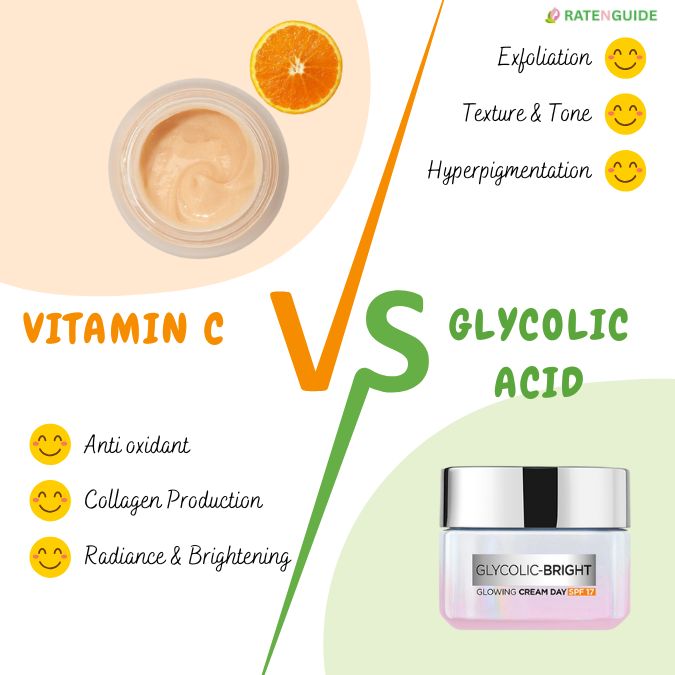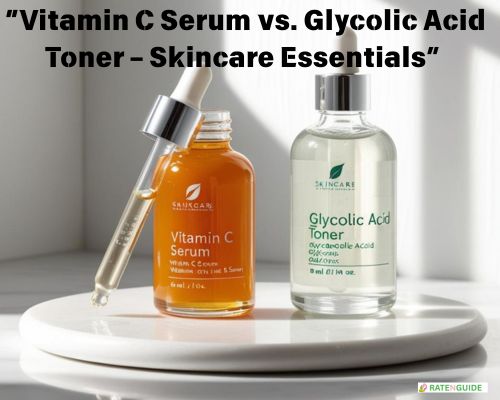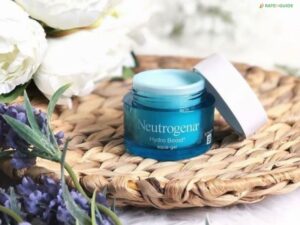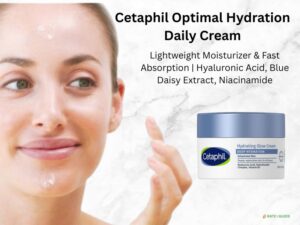When it comes to achieving radiant, glowing skin, the debate of Vitamin C vs. Glycolic Acid often comes up. Both are skincare powerhouses known for their ability to brighten, smooth, and revitalize the skin—but they work in very different ways.
So, how do you decide which one deserves a spot in your skincare routine? In this blog post, we’ll break down the differences between Vitamin C vs. Glycolic Acid, compare their benefits across multiple skincare goals, and help you choose the right one for your skin type and concerns.
Let’s dive in!
What is Vitamin C?
Vitamin C, also known as ascorbic acid, is a potent antioxidant that helps protect the skin from environmental stressors like UV rays and pollution. It plays a vital role in collagen synthesis, which helps maintain skin elasticity and reduce the appearance of fine lines and wrinkles.
There are several forms of Vitamin C used in skincare, including:
- L-Ascorbic Acid (most potent and fast-acting)
- Sodium Ascorbyl Phosphate (stable and gentle)
- Ascorbyl Glucoside, and others
Key Benefits of Vitamin C:
- Brightens dull skin
- Fades dark spots and hyperpigmentation
- Boosts collagen for firmer skin
- Provides antioxidant protection
“Read our in-depth Deconstruct 10% Vitamin C Serum Review 2025 to find the best Vitamin C for beginners.”
“Looking for a gentle Vitamin C? Check out our Minimalist Vitamin C Serum review for details.”
What is Glycolic Acid?
Glycolic Acid is an alpha-hydroxy acid (AHA) derived from sugarcane. It works as a chemical exfoliant, gently dissolving the bonds between dead skin cells to promote smoother, more even-toned skin.
It has the smallest molecule size of all AHAs, allowing it to penetrate deeper into the skin for faster results—but that also means it can be more intense, especially for sensitive skin types.
Key Benefits of Glycolic Acid:
- Exfoliates and smooths skin texture
- Reduces the appearance of fine lines
- Fades acne scars and dark spots
- Unclogs pores and improves skin clarity
Vitamin C vs. Glycolic Acid: Skin Brightening Power

Both Vitamin C and Glycolic Acid are fantastic for brightening the skin—but they work through different mechanisms.
- Vitamin C brightens by reducing melanin production and fighting free radicals that contribute to dullness and discoloration.
- Glycolic Acid brightens by exfoliating the skin’s surface, removing dead cells that can make skin look uneven or tired.
Verdict: If you’re dealing with hyperpigmentation or uneven tone, Vitamin C may offer more targeted brightening. But if your dullness is caused by a buildup of dead skin cells, Glycolic Acid might be the better choice.
Anti-Aging Benefits: Vitamin C vs. Glycolic Acid

Both Vitamin C and Glycolic Acid offer impressive anti-aging benefits, but they target different skin concerns.
- Vitamin C stimulates collagen production, which helps improve skin firmness and reduce fine lines and wrinkles over time. Its antioxidant properties also protect against premature aging caused by free radicals and UV damage.
- Glycolic Acid, on the other hand, speeds up cell turnover by exfoliating dead skin cells, revealing fresher, younger-looking skin underneath. This helps diminish the appearance of fine lines, age spots, and rough texture.
Verdict: For long-term collagen support and protection against environmental aging, Vitamin C takes the lead. However, if you want immediate smoothing and resurfacing effects, Glycolic Acid is highly effective.
Acne and Blemish Control
When comparing Vitamin C vs. Glycolic Acid for acne and blemishes, both ingredients have unique strengths:
- Vitamin C helps reduce post-acne marks (PIH) and calms inflammation, making it excellent for fading red or dark acne scars.
- Glycolic Acid is effective for preventing clogged pores, reducing breakouts, and improving skin texture through exfoliation.
Verdict: For active acne and congested skin, Glycolic Acid is more effective. For fading acne scars and brightening post-acne spots, Vitamin C is the better choice.
Exfoliation vs. Antioxidant Protection
- Glycolic Acid excels as an exfoliant, clearing away dead skin cells and promoting smoother skin. Regular exfoliation helps with dullness, rough patches, and even minor acne.
- Vitamin C is a powerful antioxidant that protects your skin from oxidative stress caused by pollution, sun exposure, and lifestyle factors. It prevents future skin damage rather than repairing existing texture issues.
Verdict: If you need to resurface and renew skin texture, choose Glycolic Acid. For protection and prevention of future skin damage, Vitamin C is essential.
Skin Type Suitability
Not every ingredient suits every skin type. Here’s how Vitamin C vs. Glycolic Acid compare:
| Skin Type | Vitamin C | Glycolic Acid |
|---|---|---|
| Dry Skin | Hydrating forms like Sodium Ascorbyl Phosphate are gentle | Can be drying if overused, needs hydrating routine |
| Oily Skin | Helps with oil balance & pigmentation | Great for exfoliating clogged pores |
| Sensitive Skin | Look for gentle derivatives like MAP | Might cause irritation or stinging |
| Acne-Prone Skin | Fades acne scars & supports healing | Clears pores & prevents breakouts |
Verdict: For sensitive skin, Vitamin C derivatives are safer. For oily and acne-prone skin, Glycolic Acid can be highly beneficial if used carefully.
How to Use in a Skincare Routine
Vitamin C Usage:
- Best applied in the morning to fight environmental damage
- Layer after cleansing and before moisturizer/sunscreen
- Suitable for daily use (if tolerated)
Glycolic Acid Usage:
- Best applied at night due to sun sensitivity
- Typically used after cleansing and before serums/moisturizers
- Start with 2-3 times per week, increase gradually
Pro Tip: Always follow up with broad-spectrum sunscreen when using either Vitamin C or Glycolic Acid to protect your skin.
Side Effects & Precautions of Using Vitamin C vs. Glycolic Acid
While both ingredients are effective, they can cause side effects if not used correctly.
Vitamin C Side Effects:
- Mild irritation or tingling sensation
- Possible breakouts during initial use
- Can oxidize quickly if not stored properly
Glycolic Acid Side Effects:
- Stinging, redness, or peeling (especially for beginners)
- Increased sun sensitivity
- Potential for over-exfoliation if overused
Precautions:
- Always do a patch test before using either ingredient.
- Introduce slowly into your routine to avoid irritation.
- Use a broad-spectrum SPF daily, especially when using Glycolic Acid.
Can You Use Vitamin C and Glycolic Acid Together in Skincare?
Yes, you can use Vitamin C and Glycolic Acid together, but with caution.
- Option 1: Alternate Days
Use Glycolic Acid on some nights for exfoliation and Vitamin C in the morning for antioxidant protection. - Option 2: Layer with Care
If layering in the same routine, apply Glycolic Acid first (after cleansing), wait 20-30 minutes, then apply Vitamin C. This minimizes irritation but is only recommended for experienced users.
Pro Tip: For sensitive skin, it’s safer to alternate days or use them in separate routines (Vitamin C in the morning, Glycolic Acid at night).
Vitamin C vs. Glycolic Acid Product Recommendations (Best for Beginners)
Here are some top-rated products for both Vitamin C and Glycolic Acid:
Best Vitamin C Serums:
- Minimalist 10% Vitamin C Face Serum (India) – Affordable & beginner-friendly
- Klair’s Freshly Juiced Vitamin Drop – Gentle for sensitive skin
- SkinCeuticals C E Ferulic – High-end, clinically proven efficacy
Best Glycolic Acid Products:
- The Ordinary Glycolic Acid 7% Toning Solution – Budget-friendly & effective
- Pixi Glow Tonic (5% Glycolic Acid) – Great for daily gentle exfoliation
- L’Oréal Paris Glycolic Bright Cream – Easily available in India for beginners
User Reviews and Results
Vitamin C Feedback:
- Users report brighter, more even-toned skin with regular use.
- Noticeable fading of dark spots and post-acne scars.
- Some experience initial purging or irritation.
Glycolic Acid Feedback:
- Popular for instantly smoother and fresher-looking skin.
- Effective in reducing texture, acne scars, and clogged pores.
- Can cause redness if overused or for sensitive skin types.
Final Verdict: Which Is Better for Glowing Skin?
In the debate of Vitamin C vs. Glycolic Acid, there’s no single winner—it depends on your skin goals and type.
- Choose Vitamin C if your primary concern is dullness, pigmentation, and anti-aging protection.
- Choose Glycolic Acid if you need exfoliation, smoother texture, and acne control.
For best results, many people benefit from using both ingredients strategically in their skincare routine.
Key Takeaway:
Both Vitamin C and Glycolic Acid are fantastic for achieving glowing skin. Whether you choose one or combine them, consistency and proper usage are the keys to radiant, healthy-looking skin.
FAQ
Q1. Can I use Vitamin C and Glycolic Acid together?
Yes, you can use both Vitamin C and Glycolic Acid, but it’s best to use them at different times of the day or on alternate days to avoid irritation. Vitamin C is ideal for mornings, while Glycolic Acid works best at night.
Q2. Which is better for hyperpigmentation – Vitamin C or Glycolic Acid?
Vitamin C targets melanin production and is excellent for fading dark spots, while Glycolic Acid exfoliates dead skin cells that contribute to uneven skin tone. For hyperpigmentation, Vitamin C offers more targeted results, but both can complement each other.
Q3. Is Glycolic Acid harsher than Vitamin C?
Glycolic Acid can be more irritating, especially for sensitive skin, as it is an exfoliant. Vitamin C is generally gentler, especially in stable derivative forms, but high concentrations can also cause irritation if not introduced gradually.
Q4. Which one is better for beginners – Vitamin C or Glycolic Acid?
For beginners, a gentle Vitamin C derivative (like Sodium Ascorbyl Phosphate) is safer to start with. Glycolic Acid should be introduced slowly, starting with lower concentrations and limited frequency.
Q5. How long does it take to see results with Vitamin C vs. Glycolic Acid?
With consistent use, Vitamin C can show brightening effects in 4-6 weeks, while Glycolic Acid often provides smoother skin and glow within 1-2 weeks due to its exfoliating action.




